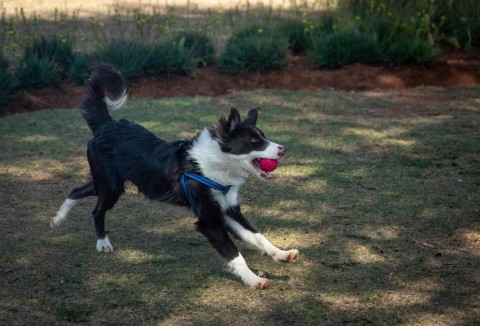Prong collar training has long been debated among dog trainers, veterinarians, and pet owners alike…
Dog training is a vital aspect of responsible pet ownership, contributing to the safety, well-being, and overall happiness of the dog and its owner.
Among the different training methods available, prong collar training has emerged as a contentious yet powerful tool for teaching dogs proper leash manners and obedience.
While experts argue its effectiveness in teaching obedience and controlling unwanted behaviors, opponents raise ethical concerns about its potential to cause harm and discomfort to dogs.
This article explores both sides of the argument surrounding prong collar training, shedding light on its benefits, risks, and ethical considerations. Let’s Begin…
Understanding Prong Collar Training
Prong collar training is also known as pinch collar training. It involves using a specialized collar with metal prongs distributed evenly around its circumference.
When tension is applied to the leash, these prongs apply pressure to the dog’s neck, mimicking the corrective behavior observed in canine social structures.
The primary goal of prong collar training is not to cause pain but to provide clear and consistent communication between the owner and the dog, facilitating obedience and better leash manners.
How Prong Collars Work?
The design of prong collars is based on natural canine behavior. In a pack, dogs communicate and establish dominance through physical cues like nipping or biting.
Prong collars exert gentle pressure around the dog’s neck, simulating the sensation of a mother dog correcting her puppies.
When used correctly, prong collars can effectively communicate with the dog, helping to discourage undesirable behaviors like pulling on the leash or lunging.
The goal is not to inflict pain but to provide clear feedback to the dog, promoting better understanding and cooperation.
The Correct Way to Use a Prong Collar:
When using a prong collar for training, it’s essential to do so safely and responsibly. Here’s a step-by-step guide on how to use a prong collar effectively:
1. Choose the Right Size:
Prong collars come in different sizes, so selecting the appropriate size for your dog is crucial. Measure your dog’s neck circumference and choose a collar that fits snugly but is not too tight. The prong collar should sit high on the neck, just below the ears.
2. Introduce Gradually:
Before using the prong collar during training, allow your dog to become familiar with wearing it. Let the dog wear the collar around the house for short periods without tension on the leash. It helps them get accustomed to the sensation of the prongs.
3. Proper Placement:
Position the prong collar high on your dog’s neck, just below the ears. It’s important to ensure the collar is fitted correctly to prevent injury and discomfort.
4. Attach Leash Correctly:
Attach the leash to the prong collar using the provided ring. Ensure the leash is securely attached to prevent it from coming loose during training.
5. Use Gentle Corrections:
Apply gentle, quick corrections rather than prolonged or forceful tugs when using the prong collar for training. The goal is to get your dog’s attention without causing pain or discomfort. Use the leash to apply light pressure when needed.
6. Timing is Key:
Correct your dog’s behavior immediately after they exhibit the unwanted behavior. Timing is crucial for effective training, as it helps your dog understand undesirable behavior.
7. Monitor Your Dog’s Response:
Pay close attention to your dog’s body language and response when using the prong collar. If your dog shows signs of discomfort, fear, or distress, discontinue its use immediately and reassess your training approach.
8. Seek Professional Guidance:
If you need help using a prong collar or encounter any difficulties during training, consider seeking guidance from a professional dog trainer. They can provide personalized advice and assistance to ensure you use the prong collar safely and effectively. Click here
Appropriate Age for Using a Prong Collar:
The appropriate age to start using a prong collar for training purposes can vary depending on the dog’s size, temperament, and individual training needs.
However, in general, it’s recommended to wait until a dog is physically mature before introducing a prong collar.
For most breeds, physical maturity occurs around 12 to 18 months of age, although smaller breeds may mature earlier, while larger breeds may take longer to reach maturity.
It’s essential to wait until your dog has reached physical maturity before using a prong collar to avoid potential harm or discomfort, as their neck muscles and skeletal structure need to be fully developed to handle the pressure from the collar properly.
Benefits of Prong Collar Training
Here are some benefits of prong collar training:
1. Improved Leash Manners:
Prong collars effectively address leash-pulling behaviors by providing immediate feedback to the dog.
The gentle pressure exerted by the collar helps the dog understand that pulling on the leash leads to discomfort, encouraging them to walk calmly by their owner’s side.
2. Enhanced Communication:
Unlike traditional collars that may cause discomfort or pain when tension is applied, prong collars provide a more nuanced communication between owner and dog.
The pressure from the prongs enables clearer communication of commands and expectations, fostering a deeper understanding between the two.
3. Quick Results:
Many dog owners report significant improvements in their dog’s behavior after just a few sessions of prong collar training.
The collar’s clear feedback facilitates quicker learning and progress in obedience training, leading to more harmonious interactions between owner and pet.
4. Safety:
When used correctly, prong collars are safer than choke collars, as they distribute pressure evenly around the dog’s neck, reducing the risk of injury to the trachea or neck muscles.
Additionally, the discomfort caused by the collar is temporary and subsides once the dog responds to the correction.
5. Improved Control:
Prong collars offer better control over strong or stubborn dogs, making walks more manageable for the owner and the pet.
6. Effective Correction:
Advocates of prong collar training claim that the discomfort caused by the collar serves as an effective deterrent for unwanted behaviors such as pulling on the leash, jumping, or excessive barking.
7. Reduced Pulling:
One of the most common issues faced by dog owners is excessive pulling on the leash. Prong collar training can address this problem by providing discomfort or pressure when the dog pulls, encouraging them to walk calmly by their owner’s side.
8. Versatility:
Prong collars can be adjusted to different intensity levels, making them suitable for dogs of various sizes and temperaments. Additionally, they can be used in conjunction with other training methods to achieve desired results effectively.
Risks and Ethical Concerns of Prong Collar Training
Some risk factors regarding prong collar training are:
1. Potential for Injury:
Critics of prong collar training argue that the pressure exerted by the prongs can cause physical injury to the dog’s neck, including puncture wounds, abrasions, and soft tissue damage, particularly if the collar is misused or applied with excessive force.
2. Fear and Anxiety:
Opponents raise concerns about the psychological impact of prong collar training on dogs, suggesting that the fear and anxiety induced by the collar may lead to behavioral issues such as aggression, fearfulness, or learned helplessness.
3. Lack of Positive Reinforcement:
Some trainers advocate positive reinforcement-based methods, emphasizing the importance of rewarding desired behaviors rather than relying on punishment or aversive techniques, which they argue can undermine the dog’s and the trainer’s bond.
4. Ethical Considerations:
Using prong collars raises ethical questions regarding the welfare and dignity of the dog. Critics argue that training methods should prioritize the well-being and emotional needs of the animal, avoiding unnecessary discomfort or coercion.
Controversies Surrounding Prong Collar Training
Despite its effectiveness, prong collar training has sparked controversy and debate within the dog training community and among animal welfare advocates. Critics argue that prong collars can cause pain, fear, and anxiety in dogs if misused or applied with excessive force.
There are concerns about the potential for negative associations with the collar, leading to aversive behaviors or psychological distress in the dog.
Addressing these concerns is essential by emphasizing responsible usage and proper training techniques. Prong collars should never be used as a punitive measure or to exert undue force on the dog.
Instead, they should be employed as a communication tool, combined with positive reinforcement techniques, to encourage desired behaviors and create a positive association with the training process.
Precautions for Using Prong Collars:
-
Fit:
Proper fit is crucial for the safe and effective use of prong collars. The collar should fit snugly around the dog’s neck, with enough room to insert one or two fingers between the collar and the skin. It should sit high on the neck, just below the ears, to ensure optimal effectiveness and comfort.
-
Gradual Introduction:
Introduce the prong collar gradually to prevent overwhelming the dog. Start by allowing the dog to become familiar with the collar without applying any tension. Gradually introduce light pressure during training sessions, rewarding the dog for appropriate responses.
-
Training Technique:
Use gentle, steady pressure when applying corrections with the prong collar. Avoid jerking or yanking the leash, which can cause discomfort and undermine training. Instead, apply consistent pressure to communicate commands and expectations to the dog.
-
Positive Reinforcement:
Combine prong collar training with positive reinforcement techniques, such as treats, praise, and affection, to reward desired behaviors and create a positive association with the training process. Positive reinforcement helps motivate the dog to comply with commands willingly and enhances their overall learning experience.
-
Consistency:
Consistency is key to successful prong collar training. Set clear expectations and reinforce commands consistently to help the dog understand what is expected of them. Consistent training builds trust and confidence between owner and pet, leading to more reliable obedience and better behavior in various situations.
Considerations for Responsible Usage:
Professional Guidance:
Before embarking on prong collar training, seek guidance from a qualified dog trainer or behaviorist. They can provide personalized advice and ensure the training meets your dog’s needs.
Monitoring:
Always monitor your dog’s response during prong collar training to ensure they are not experiencing discomfort or distress. If your dog exhibits signs of stress or pain, discontinue using the prong collar and consult a professional trainer.
Alternatives:
Prong collars are unsuitable for all dogs, and alternative training methods may be more appropriate depending on the dog’s temperament and behavior. Explore positive reinforcement techniques, clicker training, or head collars as alternatives to prong collar training.

Prong collar training can address behavioral issues and enhance communication between dogs and their owners.
However, it’s essential to approach prong collar training responsibly, with proper understanding, techniques, and consideration for the dog’s needs.
By following best practices and seeking professional guidance when needed, prong collar training can be a valuable component of a comprehensive training regimen, ultimately fostering a harmonious relationship between dogs and their owners.
Ultimately, pet owners should carefully consider the potential benefits and drawbacks of prong collar training, seeking guidance from qualified trainers and veterinarians to ensure the well-being and welfare of their canine companions.
FAQs:
-
Is a prong collar safe for my dog?
Prong collars can be safe when used correctly and responsibly. It’s essential to choose the right size and fit for your dog and to use gentle corrections rather than forceful tugs.
-
Will a prong collar hurt my dog?
When used properly, a prong collar should not cause pain to your dog. The prongs are designed to provide gentle pressure rather than sharp pain. However, it is crucial to monitor your dog’s response and discontinue use if they show signs of distress.
-
Can I use a prong collar on any dog?
Prong collars may not be suitable for all dogs. Experts typically recommend larger breeds or dogs that tend to pull on the leash. However, it’s essential to consult with a professional trainer to determine if a prong collar is appropriate for your dog’s training needs.
-
How do I fit a prong collar properly?
Ensure the prong collar fits snugly but not tight around your dog’s neck. It should sit high on the neck, just below the ears. You should be able to fit two fingers between the collar and your dog’s neck.
-
Can I always leave a prong collar on my dog?
No, Never leave prong collars on your dog all the time. They are training tools, and you should only use them during training sessions. Remove when your dog is not engaged in training activities.
-
How do I transition away from using a prong collar?
Once your dog has learned the desired behaviors, gradually transition away from using the prong collar and rely more on positive reinforcement techniques. Continue to reinforce good behavior with treats, praise, or toys.
-
Are there alternatives to using a prong collar?
Yes, alternative training tools and methods, such as front-clip harnesses, head halters, and positive reinforcement training techniques, are available. Consult with a professional trainer to determine the best approach for your dog.
-
What should I do if my dog reacts negatively to the prong collar?
If your dog shows discomfort, fear, or distress when using the prong collar, discontinue immediately. Reassess your training approach and consider alternative methods or seek guidance from a professional trainer.
-
Are prong collars legal?
Prong collars are legal in many places, but regulations may vary depending on your location. Familiarizing yourself with local laws and regulations regarding using prong collars is essential.
-
Where can I learn more about prong collar training?
You can learn more about prong collar training from reputable sources such as professional dog trainers, veterinary behaviorists, and reputable online resources. Additionally, consider attending training classes or workshops led by experienced trainers.


Thanks for sharing. I read many of your blog posts, cool, your blog is very good.
Thanks